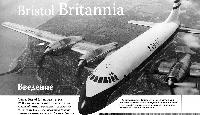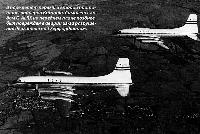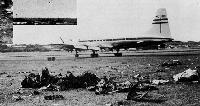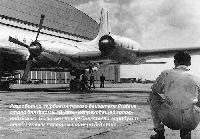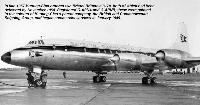
Варианты
- Bristol - Britannia / Type 175 - 1952 - Великобритания
- Canadair - CL-28 Argus - 1957 - Канада
- Canadair - CL-44 Yukon - 1960 - Канада
Bristol Type 175 Britannia
Вскоре после окончания Второй мировой войны авиакомпания BOAC выпустила технические требования на гражданский среднемагистральный транспортный самолет MRE. Пять британских авиастроительных фирм, включая "Bristol", предложили BOAC в общей сложности восемь проектов. Наиболее полно соответствовал требованиям проект Bristol Type 175, моноплан с низкорасположенным крылом, носовой стойкой шасси и гермокабиной, вмещавшей 32-36 пассажиров. Силовая установка состояла из четырех поршневых радиальных двигателей Bristol Centaurus. Мощность двигателей была явно избыточной для планируемой полезной нагрузки, поэтому решили переделать проект под перевозку 40-44 пассажиров, а позднее их число увеличили до 42-48. Ожидалось, что BOAC закажет этот вариант, но фактическим заказчиком стало британское Министерство снабжения, выдавшее 5 июля 1948 года контракт на постройку трех прототипов.
Последовали дальнейшие доработки проекта, и первый прототип, в основном соответствующий серийному лайнеру Britannia Series 100, поднялся в воздух 16 августа 1952 года. Он мог перевозить уже 90 пассажиров в туристическом классе. Силовая установка прототипа состояла из четырех ТВД Bristol Proteus мощностью по 2800 э.л.с. (2088 кВт), а на серийные самолеты Series 100 устанавливались ТВД Proteus 705, развивавшие по 3780 э. л. с. (2819 кВт). Пятнадцать таких машин, получивших обозначение Britannia 102, были построены для BOAC, и их эксплуатация началась 1 февраля 1957 года на авиалинии в Южную Африку.
Затем был создан лайнер повышенной вместимости Britannia Series 300, первый прототип которого Britannia 301 поднялся в воздух 31 июля 1956 года. Фюзеляж этого самолета был удлинен на 3,12 м, и он мог перевозить до 133 пассажиров в туристическом классе, а также совершать беспосадочные перелеты через Атлантику. Хотя BOAC заказала семь таких машин, все они достались другим авиакомпаниям: "Aeronaves de Mexico" (два Britannia 302), "Transcontinental SA" (два Britannia 305), "Air Charter" (два Britannia 307) и "Ghana Airways" (один Britannia 309).
Вместо них BOAC заказала самолеты Britannia Series 300LR (long-range - дальнемагистральные) с увеличенным запасом топлива на борту и ТВД Proteus 755 мощностью 4120 э. л. с. (3072 кВт). Обозначение Britannia Series 300LR позднее изменили на Britannia Series 310, и прототип Britannia 311 впервые поднялся в воздух 31 декабря 1956. Первый лайнер Britannia 312 был поставлен BOAC 10 сентября 1957 и использовался для испытательных полетов над Северной Атлантикой.
Последним серийным вариантом стали лайнеры Britannia Series 320, оснащенные ТВД Proteus 765 мощностью по 4450 э. л. с. (3318 кВт); были построены только две машины. Эти самолеты были арендованы авиакомпанией "Canadian Pacific Air Lines" (позднее "CP Air").
Когда начиналось серийное производство Britannia, считалось, что лайнер сможет собрать большой портфель заказов. Но появление на рынке реактивного лайнера Boeing Model 707 помешало этим планам. Всего выпустили 60 гражданских лайнеров и еще 23 самолета (три Britannia 252 и 20 Britannia 253) построили для Транспортного командования RAF, где они получили обозначение Britannia C.Mk 2 и Britannia C.Mk 1 соответственно. Эти машины на базе Series 310 отличались большим грузовым люком, и 22 из них прослужили до 1975 года, когда их сняли с вооружения. После этого самолеты раскупили небольшие авиакомпании из Африки, Европы и с Ближнего Востока. К 1982 году около десятка из них еще продолжали летать, но в течение последующего десятилетия были выведены из эксплуатации.
Последним самолетом Britannia, поставленным из Филтона в конце ноября 1960 года, был первый прототип, оснащенный к тому времени довольно необычной силовой установкой: во внутренних гондолах были установлены ТВД Proteus 705, в правой внешней гондоле - Proteus 755, а в левой - ТВД Bristol Orion мощностью 5500 э. л. с. (4101 кВт). Этот самолет закончил свои дни в качестве учебного пособия на авиабазе RAF в Сент-Эзене. Но история Britannia на этом не закончилась. В 1954 году лицензия на производство была предоставлена фирме "Canadair", которая сначала построила на базе Britannia 33 морских патрульных самолета CL-28 Argus для канадских ВВС, а затем транспортный вариант CL-44 для гражданского и военного применения.
ТАКТИКО-ТЕХНИЧЕСКИЕ ХАРАКТЕРИСТИКИ
Bristol Type 175 Britannia Series 310
Тип: дальнемагистральный лайнер
Силовая установка: четыре ТВД Bristol Proteus 755 мощностью по 4120 э.л. с. (3072 кВт)
Летные характеристики: макс, скорость 639 км/ч на оптимальной высоте; крейсерская 575 км/ч на оптимальной высоте; потолок 7315 м; дальность полета с максимальной полезной нагрузкой 6869 км
Масса: пустого 37438 кг; максимальная взлетная 83915 кг
Размеры: размах крыла 43 м; длина 37 м, высота 11,43м;площадь крыла 192,77 м!
Полезная нагрузка: до 133 пассажиров
- Описание
Фотографии
-
Air International 2008-08 / B.Hales-Dutton - Bristol Britannia /Aircraft profile/
Регистрационный номер: G-ANBJ Bristol Britannia 102, G-ANBJ, of Britannia Airways, formerly known as Euravia before the airline changed its name to reflect the new addition to the fleet. Based at Luton the airline operated six of the type on charter and holiday flights and the aircraft was a corner stone of its expansion from 1964 until the last example was retired in 1971.
-
Air International 2008-08 / B.Hales-Dutton - Bristol Britannia /Aircraft profile/
Регистрационный номер: G-AOVC Britannia 312, G-AOVC, of Donaldson International Airlines, which operated inclusive tour and charter flights, a popular use for the 'whispering giant'. Donaldson eventually bought Boeing 707s for charter flights across the Atlantic and regular Britannia operations ended in 1971 just three years before the airline's demise.
-
Air International 2008-08 / B.Hales-Dutton - Bristol Britannia /Aircraft profile/
Регистрационный номер: 4X-AGB [3] Britannia 313, 4X-AGB, of El Al Israel Airlines circa 1960. Purchased to replace the airline’s Lockheed L-049s the airline operated five Britannias on the Israeli register from 1957 until 1965. This particular aircraft ended its days with Air Spain and was scrapped at Palma, Majorca.
-
Air International 2008-08 / B.Hales-Dutton - Bristol Britannia /Aircraft profile/
Регистрационный номер: CF-CZA Britannia 314, CF-CZA, of Canadian Pacific Airlines. This airline operated one of the largest Britannia fleets with eight aircraft used on scheduled routes all over the world. The first aircraft started flying for the airline in 1958 with the last Britannia operation taking place in 1966.
-
Air Enthusiast 1972-10 / ??? - The 40-year-old newcomer: British Caledonian Airways
Регистрационный номер: G-APNA [2] Britannias have been operated in the liveries of many of the airlines which are now part of the history of British Caledonian. Illustrated are the markings of BUA's parent company, British and Commonwealth Shipping Co Ltd, on Britannia 317 G-APNA.
-
Air International 2008-08 / B.Hales-Dutton - Bristol Britannia /Aircraft profile/
Регистрационный номер: CU-T669 [2] Britannia 318, CU-T669, of Cubana. The airline operated four Britannias from 1858 until 1977 on passenger services and from 1979 until 1984 on cargo flights. In 1959 one of Cubana’s Britannias set a record on the New York - Havana route, flying it in 3 hr 28 mins, the fastest ever for a commercial flight at that time. Cubana’s Britannias also flew several other routes faster and in more comfort than its competitors helping the airline to dominate many of those services.
-
Air International 2008-08 / B.Hales-Dutton - Bristol Britannia /Aircraft profile/
Регистрационный номер: G-ARKA Britannia 324, G-ARKA, of Basle-based Tellair circa 1969. The airline operated a couple of Britannias leased from Caledonian Airways including the example illustrated which entered service in March 1969. The troubled airline ceased trading later that year. Note the extra forward window, there were several Britannia window, door and emergency exit combinations produced.
-
Jane's All the World Aircraft 1980 / Encyclopedia of Aviation - Aircraft A-Z - v2
Регистрационный номер: G-ANCA Прототип Series 300, G-ANCA, поднялся в воздух 31 июля 1956 года и позже был окрашен в цвета "Capital Airlines", хотя авиакомпания его так и не получила. В ноябре 1957 года он разбился около Филтона.
Bristol Britannia 301. -
Air International 2002-08 / R.Whitford - Fundamentals of Airliner Design /Commercial/ (10)
Регистрационный номер: G-ANBH [2] Although the Bristol Aero Engines Proteus was troublesome in its early stages, it settled down after intensive development and operated successfully in the Bristol Britannia with an overhaul life of 7,500hr.
-
Air International 2008-08 / B.Hales-Dutton - Bristol Britannia /Aircraft profile/
Pictured is one of 15 Britannia 102s that entered service with BOAC. It was due to receive a further ten, but cancelled them after a number of incidents its Britannia fleet encountered. It later received 18 of the stretched Series 300s.
-
Aeroplane Monthly 1997-12 / M.Oakey - Vintage news
Регистрационный номер: EL-WXA [2], 9Q-CJH [2], XM496 [2] Bristol Britannia EL-WXA (ex XM496 Regulus) makes a breathtaking final low pass on arriving at Kemble, its new home, on October 14, 1997.
-
Air International 2008-08 / B.Hales-Dutton - Bristol Britannia /Aircraft profile/
Регистрационный номер: G-AOVT [2] British charter carrier Monarch Airlines at one point had a fleet of eight Britannias. This example, G-AOVT, is on display at the Imperial War Museum at Duxford.
-
Aeroplane Monthly 1999-11 / M.Oakey, T.Harmsworth - News
Регистрационный номер: G-AOVT [2] Gleaming in its newly-applied paint scheme, the Duxford Aviation Society’s Britannia G-AOVT emerges from the Superhangar on September 6, 1999 after a three-year restoration.
-
Air International 2008-08 / B.Hales-Dutton - Bristol Britannia /Aircraft profile/
Регистрационный номер: G-ANCF This Britannia 308F. G-ANCF, of Invicta International illustrates a cargo variant. Freight played an important role in the evolution of the type as Canadair developed it into the CL-44.
-
Aeroplane Monthly 1993-11 / M.Oakey - Grapevine
Регистрационный номер: 9Q-CJH [2], EL-WXA [2], XM496 [2] Sole airworthy Bristol Britannia 9Q-CJH visited Filton on September 16, 1993, bound for a new freighting career with Trans-Air Cargo of Zaire which rescued it from Cuba. Originally XM496 Regulus with the RAF, the Britannia was flown Havana-Gander-Dublin and, thanks to the efforts of the Britannia Aircraft Preservation Trust’s Roger Hargreaves and the Bristol Aero Collection’s Oliver Dearden, on to Filton. It departed later in the day for Ostend and Kinshasa.
-
Aviation Historian 37 / M.Wickstead - Bringing Africa together (1)
With the Lion of Judah emblem prominently displayed on the forward fuselage, DC-6B ET-AAY (formerly ET-T-26) is refuelled at Gatwick in September 1965 in company with a rampful of treasure in the background, including several other Douglas propliners (and a Canadair C-4 Argonaut), an Ilyushin Il-18 and a Bristol Britannia.
Другие самолёты на фотографии: Canadair CL-2 / CL-4 Argonaut - Канада - 1946Douglas DC-6 / C-118 Liftmaster - США - 1946Ильюшин Ил-18 - Россия - 1957
-
Мировая Авиация 119
Регистрационный номер: G-ALBO [6] При первой публичной демонстрации на заводе фирмы "Bristol" в филтоне в июле 1952 года этот прототип с кодом G-ALBO демонстрировался неокрашенным, в цвете полированного металла. Позднее для показа на авиасалоне в Фарнборо в сентябре его окрасили в цвета компании BOAC.
-
Мировая Авиация 112
Регистрационный номер: G-ALBO [6] 16 августа 1952г.: первый полет под управлением Э.Дж.Пегга совершил прототип Bristol Britannia (G-ALBO), оснащенный пока ТВД Proteus 625.
-
Air Pictorial 1956-09 / J.Stevens - Farnborough 1956
The Britannia Type 301 made its first flight on Tuesday, 7th August with Mr. A. J. Pegg at the controls.
-
Air Pictorial 1955-09 / Air Pictorial's photo-review
Регистрационный номер: G-ANBC The third production Bristol Britannia G-ANBC taking off from Filton on its maiden flight on 29th June 1955.
-
Air Pictorial 1957-09
Britannia 310 series - long-range version ordered for world-wide service.
-
Aeroplane Monthly 1998-09 / B.Jones - Perfecting the power (3)
Регистрационный номер: G-ALBO [6] An impressive Charles E. Brown study of Bristol 175 Britannia 101 prototype G-ALBO making a flypast at the 1956 SBAC Show at Farnborough on the power of the Bristol Orion in its starboard outer nacelle and the Proteus 755 in its port outer nacelle, with the propellers of its two inboard Proteus 705s feathered.
-
Air Pictorial 1957-10 / J.Stevens - S.B.A.C. 1957
Регистрационный номер: G-ALBO [6] Bristol Britannia Srs. 100 (G-ALBO; first prototype), with Orion B.On.l in port outer, Proteus 755 in starboard outer, and two Proteus 705s;
-
Air Enthusiast 2002-09 / G.Warner - From Bombay to Bombardier (2)
Регистрационный номер: G-18-2 Bristol Britannia G-18-2 on its maiden flight at Sydenham June 1, 1957 - note the Sperrin in background.
Другие самолёты на фотографии: Short SA.4 Sperrin - Великобритания - 1951
-
Air Pictorial 1955-04 / Air Pictorial's photo-review
Регистрационный номер: G-ANBA [2] Bristol Britannia G-ANBA taking off from Filton on March 12th for high-altitude and high-temperature tests at Johannesburg and Khartoum.
-
Air Pictorial 1955-10 / J.Stevens - Farnborough 1955
Регистрационный номер: G-ALBO [6] The first prototype Britannia Srs.100 (G-ALBO) with "Bill" Pegg at the controls, illustrated the comparative low noise factor of th is 150,000-lb. a.u.w., Proteus 750-powered, B,O.A.C. airliner
-
Мировая Авиация 119
Регистрационный номер: G-ANBH [2] Надежды фирмы Bristol на успех лайнера Britannia были связаны с намерением компании BOAC закупить 25 таких машин еще до окончательного выбора его силовой установки.
-
Jane's All the World Aircraft 1980 / Encyclopedia of Aviation - Aircraft A-Z - v2
Bristol Britannia 102.
-
Мировая Авиация 119
Регистрационный номер: G-ALBO [6] Первый полет прототипа с кодом G-ALBO был прерван из-за проблем с управлением. Эти затруднения потребовали установки высокочувствительных средств управления рулями высоты.
-
Мировая Авиация 119
Регистрационный номер: G-ANBA [2] Первый серийный лайнер "Britannia" с кодом G-ANBA впервые взлетел лишь в 1954 году. Задержка была вызвана требованием компании BOAC провести дополнительные испытания на прочность после ряда катастроф лайнеров Comet I.
-
Мировая Авиация 119
Регистрационный номер: G-ALRX В паре летят первый и второй прототипы лайнеров Britannia. Самолет с кодом G-ALRX на переднем плане позднее был поврежден в аварии из-за разрушения двигателя над Херфордширом.
-
Air Pictorial 1957-09
Регистрационный номер: G-AOVB [2] Livery borne by the second Britannia 312, G-AOVB are becoming increasingly familiar.
-
Aviation Historian 7
Регистрационный номер: G-AOVJ When airline travel was still a bit of an adventure: BOAC Bristol Britannia 312 G-AOVJ.
-
Aviation Historian 15 / G.Ellis - Brothers in Arms
An RAF Bristol Britannia is marshalled in at Lusaka, Zambia, in the wake of Rhodesia’s Unilateral Declaration of Independence in 1965.
-
Air Pictorial 1957-09 / J.Stevens - Farnborough 1957
The Britannia 312;
-
Мировая Авиация 44
Шоу продолжалось и после катастрофы. На снимке - самолет Bristol Britannia выруливает среди обломков. Спустя несколько минут летчик-испытатель самолета Hawker Невилл Дьюк совершил удачное пикирование на сверхзвуковой скорости над публикой в память о погибших коллегах.
Другие самолёты на фотографии: De Havilland Sea Vixen / D.H.110 - Великобритания - 1951
-
Aviation Historian 15 / G.Ellis - Brothers in Arms
Регистрационный номер: XM518 The Javelins of No 29 Sqn and Bristol Britannia XM518 of RAF Transport Command share the limited space at Lusaka in 1966. Despite Wilson’s assertion that year that economic sanctions would see the matter resolved ‘‘within weeks rather than months”, the issue of Rhodesia’s government continued to be a thorny one in British politics throughout the next decade.
Другие самолёты на фотографии: Gloster Javelin - Великобритания - 1951
-
Мировая Авиация 119
Разработка турбовинтового двигателя Proteus стала для фирмы "Bristol" непреходящей головной болью. На этом снимке двигатели опробуют перед первым полетом лайнера Britannia.
-
Air Pictorial 1955-09
The Proteus engine, which powers the Britannia airliner, was the first high-power turboprop in the world to be officially cleared for use in passenger-carrying aircraft.
-
Air Pictorial 1977-11
Регистрационный номер: EI-BDC, XL639 The new Aer Turas Britannia 253F, EI-BDC, ex XL639, was a Luton visitor 3/9/77
-
Air Pictorial 1957-12
Регистрационный номер: XA-MEC, G-ANCB Britannia 302 XA-MEC (c/n. 12918, ex G-ANCB) was handed over to Aeronaves de Mexico on 4th November after a 6,300-mile delivery flight from Filton to Mexico City via Prestwick, Goose Bay and Miami, piloted by Capt.W. Daniel of Pan Am.
-
Air Pictorial 1958-02
Регистрационный номер: XA-MED, G-ANCC The second Britannia 302, XA-MED (c/n 12919, ex G-ANCC), was handed over in Mexico City on 17/7/57.
-
Мировая Авиация 144
Регистрационный номер: 5X-UVH Компания "African Safari Airways" эксплуатировала три Britannia в 1969-1971 годах на чартерных маршрутах из Швейцарии в Восточную Африку.
-
Air Pictorial 1977-12
Регистрационный номер: G-BEPX, 9Q-CAJ Britannia 253F G-BEPX, ex 9Q-CAJ, of A.M.A.Z. at Luton 3/9/77.
-
Aviation Historian 6 / A.Waller - A Flying Safari
Регистрационный номер: G-APNA [2] In late 1957 Hunting-Clan ordered two Bristol Britannia 317s, both of which had been delivered by November 1958. Registered G-APNA and G-APNB, these were painted in the colours of Hunting-Clan’s parent company, the British and Commonwealth Shipping Group, and began commercial services in January 1959.
-
Aeroplane Monthly 1990-02 / Personal album. Civil
Регистрационный номер: G-AOVB [2] British Eagle Britannia Srs 312 G-AOVB Endeavour at Kuching, Sarawak on a trooping charter on May 3, 1964.
-
Aeroplane Monthly 1983-09 / J.King - From Little Acorns
Gatwick in 1969, before the merger of BUA and Caledonian.
Другие самолёты на фотографии: Fokker F.28 Fellowship - Нидерланды - 1967
-
Air Pictorial 2002-05 / UK & Irish airlines since 1945 (28)
Регистрационный номер: G-ASTF In the mid-1960s, Caledonian received the first of its fleet of Bristol Britannias. This is G-ASTF at London Gatwick.
-
Aeroplane Monthly 1977-02 / G.Endres - Czechoslovakian Air Transport since 1920 (2)
Регистрационный номер: OK-MBB [2], CU-T671 [2] Bristol Britannia OK-MBB at Prague.
-
Aviation Historian 34 / M.Wickstead - Czechoslovakia's "Carefully Serving Airline"
Регистрационный номер: OK-MBB [2], CU-T671 [2] In January 1964 Bristol Britannia 318 OK-MBB became the second example of the type to be leased to CSA from Cubana, with which it had been registered CU-T671. The two Britannias - the first, OK-MBA, had been leased the previous year - operated a Prague-Havana service via New York and Prestwick. After five years of CSA service, OK-MBB was returned to Cubana in January 1969.
-
Air Enthusiast 2001-01 / T.Singfield - The Free Air of Heaven
Регистрационный номер: CU-P668 Cubana Britannia CU-P668 refuelling in Bermuda on its weekly Havana-Santa Maria-Prague schedule in 1961.
-
Мировая Авиация 144
Среди гражданских эксплуатантов Series 300 была кубинская "Cubana de Aviacion", использовавшая их на авиалинии Гавана - Нью-Йорк, а затем для полетов в Прагу. Самолеты эксплуатировались вплоть до 1984 года, хотя в последние годы использовались лишь для грузовых перевозок.
-
Air Pictorial 1978-01
Регистрационный номер: EI-BBH [2] Britannia 253 EI-BBH ‘City of Cork’ in Cyprus Airways titles at Shannon 3/11/77
-
Air International 1992-10 / G.Endres - Cyprus Airways: From regional carrier to international operator
Регистрационный номер: EI-BBH [2] Bristol Britannia freighter EI-BBH was leased from Aer Turas in 1976 to meet increasing demand for cargo services.
-
Авиация и Время 2007-02 / Р.Уррибаррес - Посланцы Фиделя (Кубинские авиаторы в Анголе. 1975-1976гг.) (1)
Регистрационный номер: CU-T669 [2] -
Air Pictorial 1969-06
Регистрационный номер: G-APNB Donaldson International Airways Britannia G-APNB "Carillon" landing at Southend on 28th March 1969 - one of three owned by the new airline
-
Air Pictorial 1957-10 / J.Stevens - S.B.A.C. 1957
Регистрационный номер: 4X-AGB [3] The second El Al Israel Airlines' Britannia Srs. 313 (4X-AGB; second production model).
-
Air Pictorial 1956-07
Britannia long-range airliners will serve the transatlantic and intercontinental routes of El Al Israel Airlines
-
Мировая Авиация 144
Регистрационный номер: 4X-AGB [3] Эксплуатация в Израиле. Израильская "El Al" получила первый лайнер Britannia Series 313 (4X-AGA) 12 сентября 1957 года. Вторая машина, 4X-AGB, использовавшаяся для подготовки экипажей, поступила в эксплуатацию в октябре, a 4X-AGC - в ноябре. Компания осуществила кругосветный учебный перелет и многочисленные перелеты через Тихий океан, a 4X-AGC выполнил беспосадочный перелет из Нью-Йорка в Тель-Авив - самый длинный тогда беспосадочный перелет в классе гражданских авиалайнеров.
-
Air Pictorial 1977-05
Регистрационный номер: 9G-ACE First visit to Birmingham of Geminair's Britannia 253 9G-ACE, diverted from Luton 9/3/77
-
Air Pictorial 1976-10
Регистрационный номер: EI-BBY Interconair's Britannia 253, EI-BBY "Deidre",at Luton 8/76
-
Мировая Авиация 68
Регистрационный номер: G-ANBM 8 декабря 1966г.: Фредди Лейкер на пресс-конференции в аэропорту Гатвик объявил о создании авиакомпании "Laker Airways" - на первых порах ее парк включал два самолета Bristol Britannia, осуществлявших чартерные перевозки в выходные дни.
-
Aviation Historian 26 / D.Stringer - The Viscount comes to America (3)
Регистрационный номер: G-ANCD, N6595C The first Bristol Britannia Series 305, G-ANCD (c/n 12920), at Filton in January 1958, painted in the colours of Northeast, for which it would have served as N6595C had the deal been completed. When Northeast failed to find funding for its fleet of five Britannias, G-ANCD was painted in Cubana colours and sent on a 23-day sales tour of Iberia, Cuba and Latin America instead.
-
Aeroplane Monthly 1980-06 / News Spotlight
Регистрационный номер: G-AOVS [3], G-BRAC [3] Time-expired Bristol Britannia G-AOVS of Redcoat Air Cargo thinly disguised as G-BRAC for ground sequence filming for the BBC TV series Buccaneers.
-
Air Pictorial 1977-09 / G.Endres - Airlines of the World
Регистрационный номер: G-AOVS [3], G-BRAC [3] Britain's newest all-cargo airline, Redcoat Air Cargo at present owns one Bristol Britannia, G-AOVS (illus.). which flew its first service tor the company on 18th May 1977
-
Air Pictorial 1977-01 / G.Endres - Airlines of the World
Регистрационный номер: OO-YCA, OO-YCB Two of Young Cargo's eight Bristol Britannias, OO-YCB and 'A
-
Air-Britain Archive 1985-03
Регистрационный номер: OO-YCH Britannia OO-YCH (2648) in full Young Cargo colours in 1976 or 1977.
-
Air-Britain Archive 1985-02
Регистрационный номер: OO-YCE Another Young Cargo Britannia, OO-YCE (2591) is at least intact in this view which was probably taken when it was in open storage at Oostende with OO-YCB.
-
Air International 1982-10
Регистрационный номер: XX367 [3] The Britannia XX367 photographed at Edmonton by Peter Ware.
-
Air-Britain Aeromilitaria 1986-02
Регистрационный номер: XL636 [3] Britannia XL636 on the runway at Le Bourget
-
Aviation Historian 12
Регистрационный номер: XL636 [3] RAF Transport Command Bristol Britannia XL636 over a glorious cloudscape. Harry Liddell captained sister aircraft XL638 which accompanied No 617 Sqn’s ill-fated Avro Vulcan global tour in 1959.
-
Мировая Авиация 77
Регистрационный номер: XL636 [3] После отказа от создания реактивного транспортного самолета Vickers V.1000, RAF заказали военный вариант Britannia. Около двух десятков поставленных машин несли службу на протяжении 1959-1976 годов.
-
Мировая Авиация 144
Britannia стал первым в Транспортном командовании британских ВВС турбовинтовым самолетом, он активно использовался для перевозок на большие расстояния в различные районы мира, являясь основой сил стратегического резерва британской Армии.
Bristol Britannia C.Mk.1, which is in service with R.A.F. Transport Command -
Aeroplane Monthly 1984-05 / P.Jarrett - Grapevine
Регистрационный номер: XX367 [3] Britannia 312 XX367 lands at Cranfield Aerodrome, Bedfordshire, at the end of a short ferry flight from the A&AEE at Boscombe Down, Wiltshire, on February 24, 1984 - the last flight of a Britannia in military markings. The aircraft has been sold to an operator in Zaire.
-
Air Pictorial 1999-07 / ??? - Comet - a golden anniversary!
Регистрационный номер: XX367 [3] July 30, 1962, was a wet day, but undeterred, No 216 Sqn displayed its new C.4s alongside a C.2 (XK669) and a Bristol Britannia at RAF Lyneham.
Другие самолёты на фотографии: De Havilland Comet / D.H.106 - Великобритания - 1949De Havilland Comet 3 / 4 - Великобритания - 1954
-
Air-Britain Aeromilitaria 1978-04
VC10, Comet C.4, Comet C.2, Britannia C.I and Belfast C.I on the parking pan at Brize
Другие самолёты на фотографии: De Havilland Comet / D.H.106 - Великобритания - 1949De Havilland Comet 3 / 4 - Великобритания - 1954Short SC.5 Belfast - Великобритания - 1964Vickers VC-10 - Великобритания - 1962
-
Air Pictorial 1964-09
British Eagle's first freight/passenger Britannia conversion
-
Air Pictorial 1957-09
Bristol Orion - world's first supercharged turboprop engine. Full take-off power to 15,000 feet
-
Air Pictorial 1957-06
The Bristol Britannia 300 Series aircraft (4 Bristol Proteus engines) can carry 30.000 lb. payload for 3,080 miles at a mean cruising speed of 365 m.p.h.
-
Air Pictorial 1957-09
One of the two G.E.C. equipped galleys in the B.O.A.C. Britannia
-
Aeroplane Monthly 1999-11 / M.Oakey, T.Harmsworth - News
Регистрационный номер: G-AOVS [3], G-BRAC [3] The rather sorry-looking fuselage of Britannia G-AOVS Amy, in use by Luton Airport’s fire section, awaits transport to a new location owing to redevelopment of its current site.
-
Air-Britain Archive 1985-02
Регистрационный номер: OO-YCC A somewhat ignominious end for Britannia OO-YCC (2577) being broken up at Gosselies 30.4.78.
-
Air Pictorial 1999-12
New for 2000 from Corgi Classics are 1:144th scale models of the Bristol Britannia in BOAC (shown), Laker and Monarch colours
-
Aeroplane Monthly 1995-12
Регистрационный номер: G-AOVM This month’s first prize is a 1/72-scale airliner model (Britannia and Constellation shown).
Другие самолёты на фотографии: Lockheed Super Constellation L-1049 / C-121C - США - 1951
-
Air Pictorial 1959-09 / Farnborough Directory
BRISTOL BRITANNIA 253: Another newcomer to Farnborough is this military transport which is entering service with No. 99 Squadron. Powered by four 4,445-e.h.p. Bristol Siddeley Proteus 255 turboprops, its dimensions are as follows: Span 142 ft. 3i in.; length 124 ft. 3 in.; height 36 ft. in.; wing area 2,075 sq. ft.
-
Jane's All the World Aircraft 1964 / 01 - Aircraft
Bristol Britannia 310 Series four-engined turboprop transport
-
Мировая Авиация 77
Bristol Type 175 Britannia 310
- Фотографии



























